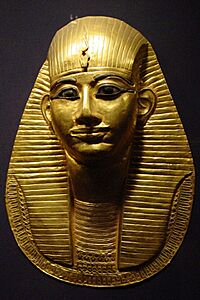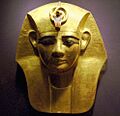Amenemope (pharaoh) facts for kids
Quick facts for kids Amenemope |
|
|---|---|

Grave mask of pharaoh Amenemope in the Cairo Museum
|
|
| Pharaoh | |
| Reign | 1001 – 992 BC or 993 – 984 BC (21st Dynasty) |
| Predecessor | Psusennes I |
| Successor | Osorkon the Elder |
| Father | Psusennes I (?) |
| Mother | Mutnedjmet(?) |
| Died | 992 or 984 BC |
| Burial | Tanis, originally NRT IV, reburied in NRT III |
Usermaatre Amenemope was an ancient Egyptian pharaoh from the 21st Dynasty. He ruled between 1001–992 BC or 993–984 BC.
Amenemope's tomb is very special. It is one of only two royal tombs found completely untouched in ancient Egypt. The other belongs to Psusennes I. Sadly, only the metal items from Amenemope's tomb survived over time.
Amenemope's Time as Pharaoh
Amenemope was likely the son of Psusennes I and Queen Mutnedjmet. He became pharaoh after his father's long rule. Some historians believe he ruled alongside his father for a while. This is called a coregency.
Evidence for this idea comes from an old linen bandage. It mentions "king Amenemope, Year 49." This might mean Year 49 of Psusennes I's rule, with Amenemope also ruling. However, some experts disagree about this.
During his reign, Amenemope also held the title of "High Priest of Amun in Tanis." His father, Psusennes I, had this title too. Amenemope's power was recognized even in Thebes. The High Priest of Amun there, Smendes II, and later his brother Pinedjem II, accepted Amenemope as pharaoh.
We know this because Amenemope's name appears on items from at least nine burials in Thebes. One important item is a Book of the Dead. It belonged to a captain named Pennestawy and dates to Amenemope's fifth year as pharaoh.
Amenemope is not as well-known as some other pharaohs. We don't have many records about him. He did continue decorating a chapel for the goddess Isis near the Giza pyramids. He also added to a temple in Memphis.
Ancient records say that Amenemope ruled for nine years. This matches what archaeologists have found. We don't know if he had any children or wives. After him, Osorkon the Elder became pharaoh. Osorkon does not seem to have been related to Amenemope.
Experts have studied Amenemope's skeleton. They found he was a strong man who lived to be quite old. It seems he had an infection in his skull. This likely led to a serious brain infection called meningitis, which caused his death.
His Burial Place
Amenemope was first buried in a small tomb (NRT IV) in the royal burial ground of Tanis. A few years after he died, during the reign of Pharaoh Siamun, his body was moved. He was reburied in a different tomb (NRT III). This new spot was next to Psusennes I, in a room that might have belonged to his mother, Mutnedjmet.
French archaeologists Pierre Montet and Georges Goyon found his untouched tomb in April 1940. This was just before World War II began. Montet had to stop his work until the war ended. He continued in 1946 and shared his discoveries in 1958.
When the archaeologists entered the burial room, they thought it was first made for Queen Mutnedjmet. Inside, they found a stone coffin that had no carvings. There were also jars, including canopic jars, which held the pharaoh's organs. A pile of about 400 small statues called ushabtis were also there.
Inside the stone coffin was a wooden coffin covered in gold. This held Amenemope's mummy. On the mummy, they found two gold-covered funerary masks. There were also two chest ornaments called pectorals, necklaces, bracelets, and rings. A fancy collar made with different colored materials was also found. Four of these items had the name of Psusennes I on them.
The funerary masks show the king as young. However, Georges Goyon said that when they were first found, the masks looked like they were in pain. After being cleaned and fixed, they looked softer. Amenemope's mummy and the items from his tomb are now in the Cairo Museum.
Amenemope's burial was not as grand as Psusennes I's. For example, Psusennes I had a coffin made of solid silver and a mask of solid gold. Amenemope's coffin and mask were only covered in gold, not made of solid gold.
See Also
Images for kids
-
Amenemope's gold pectoral depicting him before Osiris.
-
Amenemope's pectoral made from lapis lazuli and gold featuring Isis and Nephthys.





